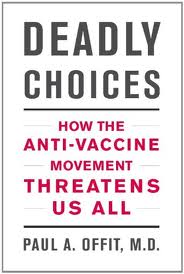
While much of this was born of the MSM’s newfound realization that the vaccine-autism connection was cooked, some of this is due to the tireless of work of those like CHOP’s Dr. Paul Offit who work get the story right.
As part of his passionate agenda to expose vaccine truths he’s published Deadly Choices – How the Anti-vaccine Movement Threatens Us All (Basic Books, 2011) (affiliate link). For those looking to understand the origins of anti-vaccine sentiment, read Deadly Choices.
What struck me is the deep history behind the anti-vaccine movement. From Jenner’s smallpox fix to modern day MMR struggles, Offit draws fascinating corollaries surrounding immunization that seem to defy the generations. Vaccine resistance was not born of Andrew Wakefield but broader concerns rooted in religion, individual liberty, fear and propaganda. Deadly Choices puts the anti-vaccine movement in a historic sequence that reads like good suspense. I couldn’t put it down.
And just for fun, I’ll bet you didn’t know this: The Raggedy Ann doll is a derivative of the anti-vaccine movement. In 1915, Johnny Gruelle, a cartoonist and illustrator in New York City, lost his daughter to congenital heart disease. Despite the child’s cause of death, Gruelle blamed the smallpox vaccine. In his daughter’s memory, he created a doll with red yarn for hair and floppy arms and legs—a symbol of children harmed by vaccines. He called it Raggedy Ann. Who knew?
Perhaps the most valuable chapter, titled “Dr. Bob,” addresses the myths and fallacies surrounding the alternate vaccine schedule as suggested by Bob Sears. This formal evisceration of “Dr. Bob” and his harebrained scheme is worth the price of the book. It should be required reading by every parent in America. Concerning Bob Sears…
Although Sears is probably well meaning, one has to question the hubris of a man who decides to create his own vaccine schedule—someone who claims his schedule is better and safer than that recommended by the CDC and AAP. It’s all the more amazing when one considers that Robert Sears has never published a paper on vaccine science; never reviewed a vaccine license application; never participated in the creation, testing, or monitoring of a vaccine; and never developed an expertise in any field that intersects with vaccines—specifically, virology, immunology, epidemiology, toxicology, microbiology, molecular biology, or statistics. Yet he believes he can sit down at his desk and come up with a better schedule.
I have to add that Deadly Choices author, Paul Offit, should be seen as the ultimate child advocate. Selflessly representing public health interests in the media, Offit individually works on behalf of children in a way that most of us should. In a self-centered world that has too quickly forgotten the threat of deadly childhood disease, Offit’s is a passionate voice of reason. It’s hard to measure the impact of his advocacy.
Despite the recent attention drawn to Andrew Wakefield’s fraudulent behavior, dialog surrounding vaccine truths can’t get enough light. To understand the history behind vaccine hesitancy is to understand the patterns of resistance to future public health efforts. Deadly Choices should be required reading by everyone concerned with the future of children’s health.
If you liked this then you might like these other vaccine-related posts on 33 charts: Vaccines, Autism and Firearms; Vaccines, Autism and the Failure of the Hive; Vaccine-Preventable Disease – The Forgotten Story; or When Autism Divides Neighbors.